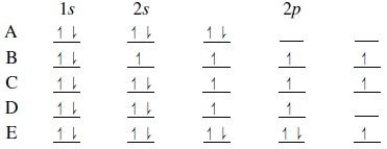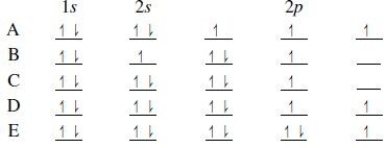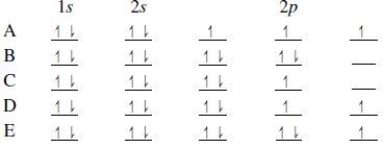Deck 6: Quantum Theory and the Electronic Structure of Atoms
Question
Question
Question
Question
Question
Question
Question
Question
Question
Question
Question
Question
Question
Question
Question
Question
Question
Question
Question
Question
Question
Question
Question
Question
Question
Question
Question
Question
Question
Question
Question
Question
Question
Question
Question
Question
Question
Question
Question
Question
Question
Question
Question
Question
Question
Question
Question
Question
Question
Question
Question
Question
Question
Question
Question
Question
Question
Question
Question
Question
Question
Question
Question
Question
Question
Question
Question
Question
Question
Question
Question
Question
Question
Question
Question
Question
Question
Question
Question
Question

Unlock Deck
Sign up to unlock the cards in this deck!
Unlock Deck
Unlock Deck
1/135
Play
Full screen (f)
Deck 6: Quantum Theory and the Electronic Structure of Atoms
1
In the ________, electrons are ejected from the surface of a metal exposed to light of a certain minimum frequency.
A) aura effect
B) photon effect
C) ritzwald effect
D) photoelectric effect
E) None of the answers is correct.
A) aura effect
B) photon effect
C) ritzwald effect
D) photoelectric effect
E) None of the answers is correct.
photoelectric effect
2
What is the energy in joules of a mole of photons associated with red light of wavelength 7.00 × 102 nm? (c = 3.00 × 108 m/s; h = 6.63 × 10-34 J • s; NA = 6.022 × 1023 /mole)
A) 256 kJ
B) 1.71 × 105 J
C) 4.72 × 10-43 J
D) 12.4 kJ
E) 2.12 × 1042 J
A) 256 kJ
B) 1.71 × 105 J
C) 4.72 × 10-43 J
D) 12.4 kJ
E) 2.12 × 1042 J
1.71 × 105 J
3
Select the arrangement of electromagnetic radiation which starts with the shortest wavelength and increases to longest wavelength.
A) radio, infrared, ultraviolet, gamma rays
B) radio, ultraviolet, infrared, gamma rays
C) gamma rays, radio, ultraviolet, infrared
D) gamma rays, infrared, radio, ultraviolet
E) gamma rays, ultraviolet, infrared, radio
A) radio, infrared, ultraviolet, gamma rays
B) radio, ultraviolet, infrared, gamma rays
C) gamma rays, radio, ultraviolet, infrared
D) gamma rays, infrared, radio, ultraviolet
E) gamma rays, ultraviolet, infrared, radio
gamma rays, ultraviolet, infrared, radio
4
When a solid is heated, it emits electromagnetic radiation known as ________. An example of such radiation is the element of a stove stop burning bright red.
A) isoelectric radiation
B) visible and ultraviolet radiation
C) blackbody radiation
D) paramagnetic radiation
E) whitebody radiation
A) isoelectric radiation
B) visible and ultraviolet radiation
C) blackbody radiation
D) paramagnetic radiation
E) whitebody radiation

Unlock Deck
Unlock for access to all 135 flashcards in this deck.
Unlock Deck
k this deck
5
What is defined as the vertical distance from the midline of a wave to the top of the peak or the bottom of the trough?
A) light
B) amplitude
C) magnitude
D) wavelength
E) frequency
A) light
B) amplitude
C) magnitude
D) wavelength
E) frequency

Unlock Deck
Unlock for access to all 135 flashcards in this deck.
Unlock Deck
k this deck
6
What is the frequency of electromagnetic radiation with wavelength 532 nm? (c = 3.00 × 108 m/s)
A) 5.64 × 1014 s-1
B) 6.48 × 1012 s-1
C) 4.18 × 1018 s-1
D) 6.23 × 1014 s-1
E) 3.75 × 1015 s-1
A) 5.64 × 1014 s-1
B) 6.48 × 1012 s-1
C) 4.18 × 1018 s-1
D) 6.23 × 1014 s-1
E) 3.75 × 1015 s-1

Unlock Deck
Unlock for access to all 135 flashcards in this deck.
Unlock Deck
k this deck
7
What is defined as the number of waves that pass through a particular point in one second?
A) light
B) amplitude
C) magnitude
D) wavelength
E) frequency
A) light
B) amplitude
C) magnitude
D) wavelength
E) frequency

Unlock Deck
Unlock for access to all 135 flashcards in this deck.
Unlock Deck
k this deck
8
Calculate the frequency of visible light having a wavelength of 686 nm. (c = 3.00 × 108 m/s)
A) 4.37 × 1014 s-1
B) 4.34 × 105 s-1
C) 6.17 × 1014 s-1
D) 2.29 × 10-15 s-1
E) 2.29 × 10-6 s-1
A) 4.37 × 1014 s-1
B) 4.34 × 105 s-1
C) 6.17 × 1014 s-1
D) 2.29 × 10-15 s-1
E) 2.29 × 10-6 s-1

Unlock Deck
Unlock for access to all 135 flashcards in this deck.
Unlock Deck
k this deck
9
The FM station KDUL broadcasts music at 99.1 MHz. Find the wavelength of these waves. (c = 3.00 × 108 m/s)
A) 1.88 × 10-2 m
B) 0.330 m
C) 3.03 m
D) 5.33 × 102 m
E) > 103 m
A) 1.88 × 10-2 m
B) 0.330 m
C) 3.03 m
D) 5.33 × 102 m
E) > 103 m

Unlock Deck
Unlock for access to all 135 flashcards in this deck.
Unlock Deck
k this deck
10
What is the frequency of light having a wavelength of 360 nm? (c = 3.00 x 108 m/s)
A) 8.3 × 1014 s-1
B) 1.2 × 10-6 s-1
C) 8.3 × 105 s-1
D) 108 s-1
E) 1.2 × 10-15 s-1
A) 8.3 × 1014 s-1
B) 1.2 × 10-6 s-1
C) 8.3 × 105 s-1
D) 108 s-1
E) 1.2 × 10-15 s-1

Unlock Deck
Unlock for access to all 135 flashcards in this deck.
Unlock Deck
k this deck
11
What is the wavelength of light having a frequency of 4.8 × 1014 s-1? (c = 3.00 x 108 m/s)
A) 0.0016 nm
B) 1600 m
C) 630 nm
D) 1600 nm
E) 6.3 × 10-7 nm
A) 0.0016 nm
B) 1600 m
C) 630 nm
D) 1600 nm
E) 6.3 × 10-7 nm

Unlock Deck
Unlock for access to all 135 flashcards in this deck.
Unlock Deck
k this deck
12
Select the arrangement of electromagnetic radiation which starts with the lowest energy and increases to the greatest energy.
A) radio, infrared, ultraviolet, gamma rays
B) radio, ultraviolet, infrared, gamma rays
C) gamma rays, infrared, radio, ultraviolet
D) gamma rays, ultraviolet, infrared, radio
E) infrared, ultraviolet, radio, gamma rays
A) radio, infrared, ultraviolet, gamma rays
B) radio, ultraviolet, infrared, gamma rays
C) gamma rays, infrared, radio, ultraviolet
D) gamma rays, ultraviolet, infrared, radio
E) infrared, ultraviolet, radio, gamma rays

Unlock Deck
Unlock for access to all 135 flashcards in this deck.
Unlock Deck
k this deck
13
A(n) ________ is a point at which a standing wave has zero amplitude.
A) crevice
B) node
C) pit
D) burrow
E) orbital
A) crevice
B) node
C) pit
D) burrow
E) orbital

Unlock Deck
Unlock for access to all 135 flashcards in this deck.
Unlock Deck
k this deck
14
What is the wavelength of radiation that has a frequency of 6.912 × 1014 s-1? (c = 3.00 × 108 m/s)
A) 1.447 × 10-15 nm
B) 4.337 × 102 nm
C) 2.304 × 106 nm
D) 2.074 × 1023 nm
E) 4.337 × 10-7 nm
A) 1.447 × 10-15 nm
B) 4.337 × 102 nm
C) 2.304 × 106 nm
D) 2.074 × 1023 nm
E) 4.337 × 10-7 nm

Unlock Deck
Unlock for access to all 135 flashcards in this deck.
Unlock Deck
k this deck
15
What is defined as the distance between identical points on successive waves?
A) frequency
B) amplitude
C) magnitude
D) wavelength
E) light
A) frequency
B) amplitude
C) magnitude
D) wavelength
E) light

Unlock Deck
Unlock for access to all 135 flashcards in this deck.
Unlock Deck
k this deck
16
Visible light, radio waves, microwave radiation, infrared, ultraviolet radiation, X-rays, and gamma rays all constitute the electromagnetic spectrum. Which of the following characteristics do all of these kinds of radiation share?
A) They all have the ability to generate heat in objects.
B) They all have the same frequencies.
C) They are all the transmission of energy in the form of waves.
D) They have equal energies.
E) They have the same electron spin state.
A) They all have the ability to generate heat in objects.
B) They all have the same frequencies.
C) They are all the transmission of energy in the form of waves.
D) They have equal energies.
E) They have the same electron spin state.

Unlock Deck
Unlock for access to all 135 flashcards in this deck.
Unlock Deck
k this deck
17
What is the energy in joules of a mole of photons associated with visible light of wavelength 486 nm? (c = 3.00 × 108 m/s; h = 6.63 × 10-34 J • s; NA = 6.022 × 1023 moles-1)
A) 6.46 × 10-16 J
B) 6.46 × 10-25 J
C) 2.46 × 10-4 J
D) 12.4 kJ
E) 246 kJ
A) 6.46 × 10-16 J
B) 6.46 × 10-25 J
C) 2.46 × 10-4 J
D) 12.4 kJ
E) 246 kJ

Unlock Deck
Unlock for access to all 135 flashcards in this deck.
Unlock Deck
k this deck
18
According to scientist James Clerk Maxwell in the year 1873, a(n) ________ consists of an electric field component and a magnetic field component.
A) electrostatic wave
B) isoelectric wave
C) atom
D) paramagnetic wave
E) electromagnetic wave
A) electrostatic wave
B) isoelectric wave
C) atom
D) paramagnetic wave
E) electromagnetic wave

Unlock Deck
Unlock for access to all 135 flashcards in this deck.
Unlock Deck
k this deck
19
The solar radiation spectrum peaks at a wavelength of approximately 500 nm. Calculate the energy of one photon of that radiation (c = 3.00 × 108 m/s; h = 6.63 × 10-34 J • s).
A) 4 × 10-10 J
B) 6 × 1014 J
C) 1 × 10-27 J
D) 2 × 10-25 J
E) 4 × 10-19 J
A) 4 × 10-10 J
B) 6 × 1014 J
C) 1 × 10-27 J
D) 2 × 10-25 J
E) 4 × 10-19 J

Unlock Deck
Unlock for access to all 135 flashcards in this deck.
Unlock Deck
k this deck
20
A radio wave has a frequency of 8.6 × 108 Hz. What is the energy of one photon of this radiation? (h = 6.63 × 10-34 J • s)
A) 7.7 × 10-43 J
B) 2.3 × 10-34 J
C) 5.7 × 10-25 J
D) 1.7 × 10-16 J
E) > 10-15 J
A) 7.7 × 10-43 J
B) 2.3 × 10-34 J
C) 5.7 × 10-25 J
D) 1.7 × 10-16 J
E) > 10-15 J

Unlock Deck
Unlock for access to all 135 flashcards in this deck.
Unlock Deck
k this deck
21
Calculate the frequency of the light emitted by a hydrogen atom during a transition of its electron from the n = 4 to the n = 1 principal energy level. Recall that for hydrogen En = -2.18 × 10-18 J(1/n2 ). (h = 6.63 × 10-34 J • s)
A) 3.08 × 1015 s-1
B) 1.03 × 108 s-1
C) 2.06 × 1014 s-1
D) 1.35 × 10-51 s-1
E) 8.22 × 1014 s-1
A) 3.08 × 1015 s-1
B) 1.03 × 108 s-1
C) 2.06 × 1014 s-1
D) 1.35 × 10-51 s-1
E) 8.22 × 1014 s-1

Unlock Deck
Unlock for access to all 135 flashcards in this deck.
Unlock Deck
k this deck
22
The de Broglie equation predicts that the wavelength (in m) of a proton moving at 1000. m/s is ________. (h = 6.63 × 10-34 J • s; mass of a proton = 1.673 × 10-24 g)
A) 3.96 × 10-10 m
B) 3.96 × 10-7 m
C) 2.52 × 106 m
D) 2.52 × 109 m
E) > 1010 m
A) 3.96 × 10-10 m
B) 3.96 × 10-7 m
C) 2.52 × 106 m
D) 2.52 × 109 m
E) > 1010 m

Unlock Deck
Unlock for access to all 135 flashcards in this deck.
Unlock Deck
k this deck
23
Calculate the de Broglie wavelength associated with a 20Ne+ ion moving at a velocity of 2.0 × 105 m/s. The atomic mass of Ne-20 is 19.992 amu. (1 amu = 1.66 × 10-24 g and h = 6.63 × 10-34 J • s)
A) 1.0 × 10-13 m
B) 1.0 × 10-16 m
C) 1.0 × 10-18 m
D) 9.7 × 1012 m
E) 2.0 × 10-13 cm
A) 1.0 × 10-13 m
B) 1.0 × 10-16 m
C) 1.0 × 10-18 m
D) 9.7 × 1012 m
E) 2.0 × 10-13 cm

Unlock Deck
Unlock for access to all 135 flashcards in this deck.
Unlock Deck
k this deck
24
Which scientist proposed that energy of radiation is composed of extremely small indivisible packages called quanta? ("Quanta" is the plural of "quantum.")
A) Max Planck
B) Louis de Broglie
C) Clinton Davisson
D) Sir Isaac Newton
E) Lothan Meyer
A) Max Planck
B) Louis de Broglie
C) Clinton Davisson
D) Sir Isaac Newton
E) Lothan Meyer

Unlock Deck
Unlock for access to all 135 flashcards in this deck.
Unlock Deck
k this deck
25
What is the emission of light at only specific wavelengths?
A) Emission spectra
B) Hydrogen spectrum
C) Wave spectra
D) Limited spectra
E) Line spectra
A) Emission spectra
B) Hydrogen spectrum
C) Wave spectra
D) Limited spectra
E) Line spectra

Unlock Deck
Unlock for access to all 135 flashcards in this deck.
Unlock Deck
k this deck
26
A photon has an energy of 5.53 × 10-17 J. What is its frequency in s-1 (h = 6.63 × 10-34 J • s)?
A) 3.66 × 10-50 s-1
B) 1.20 × 10-17 s-1
C) 3.59 × 10-9 s-1
D) 2.78 × 108 s-1
E) 8.34 × 1016 s-1
A) 3.66 × 10-50 s-1
B) 1.20 × 10-17 s-1
C) 3.59 × 10-9 s-1
D) 2.78 × 108 s-1
E) 8.34 × 1016 s-1

Unlock Deck
Unlock for access to all 135 flashcards in this deck.
Unlock Deck
k this deck
27
The orientation in space of an atomic orbital is associated with
A) the principal quantum number (n).
B) the angular momentum quantum number (l).
C) the magnetic quantum number (ml).
D) the spin quantum number (ms).
E) none of these choices is correct.
A) the principal quantum number (n).
B) the angular momentum quantum number (l).
C) the magnetic quantum number (ml).
D) the spin quantum number (ms).
E) none of these choices is correct.

Unlock Deck
Unlock for access to all 135 flashcards in this deck.
Unlock Deck
k this deck
28
Use the Rydberg equation to calculate the frequency of a photon absorbed when the hydrogen atom undergoes a transition from n1 = 2 to n2 = 4. (R = 1.096776 × 107 m-1; c = 3.00 × 108 m/s)
A) 2.06 × 106 s-1
B) 2.74 × 106 s-1
C) 6.17 × 1014 s-1
D) 8.23 × 1014 s-1
E) > 1015 s-1
A) 2.06 × 106 s-1
B) 2.74 × 106 s-1
C) 6.17 × 1014 s-1
D) 8.23 × 1014 s-1
E) > 1015 s-1

Unlock Deck
Unlock for access to all 135 flashcards in this deck.
Unlock Deck
k this deck
29
The word ________ is used as an acronym for the amplification of light which is stimulated by the emission of radiation.
A) beam
B) laser
C) emit
D) brighten
E) light
A) beam
B) laser
C) emit
D) brighten
E) light

Unlock Deck
Unlock for access to all 135 flashcards in this deck.
Unlock Deck
k this deck
30
If the energy of a photon is 1.32 × 10-18 J, what is its wavelength in nm (c = 3.00 × 108 m/s; h = 6.63 × 10-34 J • s)?
A) 1.51 × 10-7 nm
B) 151 nm
C) 1.99 × 1015 nm
D) 1.99 × 1024 nm
E) None of these choices is correct.
A) 1.51 × 10-7 nm
B) 151 nm
C) 1.99 × 1015 nm
D) 1.99 × 1024 nm
E) None of these choices is correct.

Unlock Deck
Unlock for access to all 135 flashcards in this deck.
Unlock Deck
k this deck
31
Atomic orbitals developed using quantum mechanics
A) describe regions of space in which one is most likely to find an electron.
B) describe exact paths for electron motion.
C) give a description of the atomic structure which is essentially the same as the Bohr model.
D) allow scientists to calculate an exact volume for the hydrogen atom.
E) are in conflict with the Heisenberg uncertainty principle.
A) describe regions of space in which one is most likely to find an electron.
B) describe exact paths for electron motion.
C) give a description of the atomic structure which is essentially the same as the Bohr model.
D) allow scientists to calculate an exact volume for the hydrogen atom.
E) are in conflict with the Heisenberg uncertainty principle.

Unlock Deck
Unlock for access to all 135 flashcards in this deck.
Unlock Deck
k this deck
32
The shape of an atomic orbital is associated with
A) the principal quantum number (n).
B) the angular momentum quantum number (l).
C) the magnetic quantum number (ml).
D) the spin quantum number (ms).
E) the magnetic and spin quantum numbers, together.
A) the principal quantum number (n).
B) the angular momentum quantum number (l).
C) the magnetic quantum number (ml).
D) the spin quantum number (ms).
E) the magnetic and spin quantum numbers, together.

Unlock Deck
Unlock for access to all 135 flashcards in this deck.
Unlock Deck
k this deck
33
Calculate the de Broglie wavelength of a neutron that has a velocity of 200. cm/s. (mass of a neutron = 1.675 × 10-27 kg and h = 6.63 × 10-34 J • s)
A) 1.98 × 10-9 m
B) 216 nm
C) 1.8 × 1050 m
D) 198 nm
E) 5.05 mm
A) 1.98 × 10-9 m
B) 216 nm
C) 1.8 × 1050 m
D) 198 nm
E) 5.05 mm

Unlock Deck
Unlock for access to all 135 flashcards in this deck.
Unlock Deck
k this deck
34
The size of an atomic orbital is associated with
A) the principal quantum number (n).
B) the angular momentum quantum number (l).
C) the magnetic quantum number (ml).
D) the spin quantum number (ms).
E) the angular momentum and magnetic quantum numbers, together.
A) the principal quantum number (n).
B) the angular momentum quantum number (l).
C) the magnetic quantum number (ml).
D) the spin quantum number (ms).
E) the angular momentum and magnetic quantum numbers, together.

Unlock Deck
Unlock for access to all 135 flashcards in this deck.
Unlock Deck
k this deck
35
Calculate the energy, in joules, required to excite a hydrogen atom by causing an electronic transition from the n = 1 to the n = 4 principal energy level. Recall that the energy levels of the H atom are given by En = -2.18 × 10-18 J(1/n2).
A) 2.07 × 10-29 J
B) 2.19 × 105 J
C) 2.04 × 10-18 J
D) 3.27 × 10-17 J
E) 2.25 × 10-18 J
A) 2.07 × 10-29 J
B) 2.19 × 105 J
C) 2.04 × 10-18 J
D) 3.27 × 10-17 J
E) 2.25 × 10-18 J

Unlock Deck
Unlock for access to all 135 flashcards in this deck.
Unlock Deck
k this deck
36
According to the Heisenberg uncertainty principle, if the uncertainty in the speed of an electron is 3.5 × 103 m/s, the uncertainty in its position (in m) is at least ________. (mass of an electron = 9.11 × 10-28 g)
A) 1.7 × 10-8 m
B) 6.6 × 10-8 m
C) 17 m
D) 66 m
E) None of these choices is correct.
A) 1.7 × 10-8 m
B) 6.6 × 10-8 m
C) 17 m
D) 66 m
E) None of these choices is correct.

Unlock Deck
Unlock for access to all 135 flashcards in this deck.
Unlock Deck
k this deck
37
The energy of an electron in the hydrogen atom is determined by
A) the principal quantum number (n) only.
B) the angular momentum quantum number (l) only.
C) the principal and angular momentum quantum numbers (n & l).
D) the principal and magnetic quantum numbers (n & ml).
E) the principal, angular momentum, and magnetic quantum numbers.
A) the principal quantum number (n) only.
B) the angular momentum quantum number (l) only.
C) the principal and angular momentum quantum numbers (n & l).
D) the principal and magnetic quantum numbers (n & ml).
E) the principal, angular momentum, and magnetic quantum numbers.

Unlock Deck
Unlock for access to all 135 flashcards in this deck.
Unlock Deck
k this deck
38
Line spectra from all regions of the electromagnetic spectrum, including the Paschen series of infrared lines for hydrogen, are used by astronomers to identify elements present in the atmospheres of stars. Calculate the wavelength of the photon emitted when the hydrogen atom undergoes a transition from n = 5 to n = 3. (R = 1.096776 × 107 m-1)
A) 205.1 nm
B) 384.6 nm
C) 683.8 nm
D) 1282 nm
E) > 1500 nm
A) 205.1 nm
B) 384.6 nm
C) 683.8 nm
D) 1282 nm
E) > 1500 nm

Unlock Deck
Unlock for access to all 135 flashcards in this deck.
Unlock Deck
k this deck
39
A sprinter must average 24.0 mi/h to win a 100-m dash in 9.30 s. What is his de Broglie wavelength at this speed if his mass is 84.5 kg ? (h = 6.63 × 10-34 J • s)
A) 7.31 × 10-37 m
B) 3.26 × 10-37 m
C) 5.08 × 10-30 m
D) 1.34 × 10-30 m
E) None of these choices is correct.
A) 7.31 × 10-37 m
B) 3.26 × 10-37 m
C) 5.08 × 10-30 m
D) 1.34 × 10-30 m
E) None of these choices is correct.

Unlock Deck
Unlock for access to all 135 flashcards in this deck.
Unlock Deck
k this deck
40
Calculate the wavelength, in nanometers, of the light emitted by a hydrogen atom when its electron drops from the n = 7 to the n = 4 principal energy level. Recall that the energy levels of the H atom are given by En = -2.18 × 10-18 J (1/n2). (c = 3.00 × 108 m/s; h = 6.63 × 10-34 J • s)
A) 4.45 × 10-20 nm
B) 2.16 × 10-6 nm
C) 9.18 × 10-20 nm
D) 1.38 × 1014 nm
E) 2.17 × 103 nm
A) 4.45 × 10-20 nm
B) 2.16 × 10-6 nm
C) 9.18 × 10-20 nm
D) 1.38 × 1014 nm
E) 2.17 × 103 nm

Unlock Deck
Unlock for access to all 135 flashcards in this deck.
Unlock Deck
k this deck
41
Which of the following is a correct set of quantum numbers for an electron in a 5f orbital?
A) n = 5, l = 3, ml = +1
B) n = 5, l = 2, ml = +3
C) n = 4, l = 3, ml = 0
D) n = 4, l = 2, ml = +1
E) n = 5, l = 4, ml = 3.
A) n = 5, l = 3, ml = +1
B) n = 5, l = 2, ml = +3
C) n = 4, l = 3, ml = 0
D) n = 4, l = 2, ml = +1
E) n = 5, l = 4, ml = 3.

Unlock Deck
Unlock for access to all 135 flashcards in this deck.
Unlock Deck
k this deck
42
What type of configuration specifies the arrangement of electrons in the orbitals of an atom?
A) Heisenberg configuration
B) Nuclear configuration
C) Atomic configuration
D) Proton configuration
E) Electron configuration
A) Heisenberg configuration
B) Nuclear configuration
C) Atomic configuration
D) Proton configuration
E) Electron configuration

Unlock Deck
Unlock for access to all 135 flashcards in this deck.
Unlock Deck
k this deck
43
The maximum number of electrons that can occupy an energy level described by the principal quantum number, n, is
A) n.
B) n + 1.
C) 2n.
D) 2n2.
E) n2.
A) n.
B) n + 1.
C) 2n.
D) 2n2.
E) n2.

Unlock Deck
Unlock for access to all 135 flashcards in this deck.
Unlock Deck
k this deck
44
A possible set of quantum numbers for the last electron added to complete an atom of gallium (Ga) in its ground state is 
A) A
B) B
C) C
D) D
E) E

A) A
B) B
C) C
D) D
E) E

Unlock Deck
Unlock for access to all 135 flashcards in this deck.
Unlock Deck
k this deck
45
What is the maximum number of electrons in an atom that can have the following set of quantum numbers? n = 4, l = 3, ml = -2, ms = +1/2
A) 0
B) 1
C) 2
D) 6
E) 10
A) 0
B) 1
C) 2
D) 6
E) 10

Unlock Deck
Unlock for access to all 135 flashcards in this deck.
Unlock Deck
k this deck
46
The Pauli exclusion principle states that no ________ electrons within an atom can have the same ________ quantum numbers.
A) 4; 6
B) 2; 4
C) 3; 6
D) 6; 10
E) 3; 8
A) 4; 6
B) 2; 4
C) 3; 6
D) 6; 10
E) 3; 8

Unlock Deck
Unlock for access to all 135 flashcards in this deck.
Unlock Deck
k this deck
47
In the quantum mechanical treatment of the hydrogen atom, which one of the following combinations of quantum numbers is not allowed? 
A) A
B) B
C) C
D) D
E) E

A) A
B) B
C) C
D) D
E) E

Unlock Deck
Unlock for access to all 135 flashcards in this deck.
Unlock Deck
k this deck
48
Atomic orbitals that have the same amount of energy are ________.
A) regenerative
B) negatively charged
C) degenerate
D) positively charged
E) zwitterionic
A) regenerative
B) negatively charged
C) degenerate
D) positively charged
E) zwitterionic

Unlock Deck
Unlock for access to all 135 flashcards in this deck.
Unlock Deck
k this deck
49
The number of orbitals in a d subshell is
A) 1.
B) 2.
C) 3.
D) 5.
E) 7.
A) 1.
B) 2.
C) 3.
D) 5.
E) 7.

Unlock Deck
Unlock for access to all 135 flashcards in this deck.
Unlock Deck
k this deck
50
Which of the following is a correct set of quantum numbers for an electron in a 3d orbital?
A) n = 3, l = 0, ml = -1
B) n = 3, l = 1, ml = +3
C) n = 3, l = 2, ml = 3
D) n = 3, l = 3, ml = +2
E) n = 3, l = 2, ml = -2
A) n = 3, l = 0, ml = -1
B) n = 3, l = 1, ml = +3
C) n = 3, l = 2, ml = 3
D) n = 3, l = 3, ml = +2
E) n = 3, l = 2, ml = -2

Unlock Deck
Unlock for access to all 135 flashcards in this deck.
Unlock Deck
k this deck
51
Electrons in an orbital with l = 3 are in a/an
A) d orbital.
B) f orbital.
C) g orbital.
D) p orbital.
E) s orbital.
A) d orbital.
B) f orbital.
C) g orbital.
D) p orbital.
E) s orbital.

Unlock Deck
Unlock for access to all 135 flashcards in this deck.
Unlock Deck
k this deck
52
________ is the wavelength associated with a moving particle.
A) The de Broglie wavelength
B) The Heisenburg wavelength
C) The Hund wavelength
D) The Aufbau wavelength
E) None of the answers is correct.
A) The de Broglie wavelength
B) The Heisenburg wavelength
C) The Hund wavelength
D) The Aufbau wavelength
E) None of the answers is correct.

Unlock Deck
Unlock for access to all 135 flashcards in this deck.
Unlock Deck
k this deck
53
Hund's rule states that the most stable arrangement of electrons in orbitals of equal energy is the one in which the number of electrons with parallel spin is ________.
A) minimized
B) nullified
C) neutral
D) maximized
E) not relevant
A) minimized
B) nullified
C) neutral
D) maximized
E) not relevant

Unlock Deck
Unlock for access to all 135 flashcards in this deck.
Unlock Deck
k this deck
54
Which one of the following sets of quantum numbers is not possible? 
A) A
B) B
C) C
D) D
E) E

A) A
B) B
C) C
D) D
E) E

Unlock Deck
Unlock for access to all 135 flashcards in this deck.
Unlock Deck
k this deck
55
How many orbitals are allowed in a subshell if the angular momentum quantum number for electrons in that subshell is 3?
A) 1
B) 3
C) 5
D) 7
E) 9
A) 1
B) 3
C) 5
D) 7
E) 9

Unlock Deck
Unlock for access to all 135 flashcards in this deck.
Unlock Deck
k this deck
56
Which one of the following sets of quantum numbers is not possible? 
A) A
B) B
C) C
D) D
E) E

A) A
B) B
C) C
D) D
E) E

Unlock Deck
Unlock for access to all 135 flashcards in this deck.
Unlock Deck
k this deck
57
A possible set of quantum numbers for the last electron added to complete an atom of germanium in its ground state is 
A) A
B) B
C) C
D) D
E) E

A) A
B) B
C) C
D) D
E) E

Unlock Deck
Unlock for access to all 135 flashcards in this deck.
Unlock Deck
k this deck
58
Which one of the following sets of quantum numbers can correctly represent a 3p orbital? 
A) A
B) B
C) C
D) D
E) E

A) A
B) B
C) C
D) D
E) E

Unlock Deck
Unlock for access to all 135 flashcards in this deck.
Unlock Deck
k this deck
59
The most stable arrangement of electrons in orbitals of equal energy is the one in which the number of electrons with the same spin is maximized is
A) the Pauli exclusion principle.
B) Bohr's equation.
C) Hund's rule.
D) de Broglie's relation.
E) Dalton's atomic theory.
A) the Pauli exclusion principle.
B) Bohr's equation.
C) Hund's rule.
D) de Broglie's relation.
E) Dalton's atomic theory.

Unlock Deck
Unlock for access to all 135 flashcards in this deck.
Unlock Deck
k this deck
60
"No two electrons in an atom can have the same four quantum numbers" is a statement of
A) the Pauli exclusion principle.
B) Bohr's equation.
C) Hund's rule.
D) de Broglie's relation.
E) Dalton's atomic theory.
A) the Pauli exclusion principle.
B) Bohr's equation.
C) Hund's rule.
D) de Broglie's relation.
E) Dalton's atomic theory.

Unlock Deck
Unlock for access to all 135 flashcards in this deck.
Unlock Deck
k this deck
61
The electronic structure 1s22s22p63s23p64s23d8 refers to the ground state of
A) Kr.
B) Ni.
C) Fe.
D) Pd.
E) None of these choices is correct.
A) Kr.
B) Ni.
C) Fe.
D) Pd.
E) None of these choices is correct.

Unlock Deck
Unlock for access to all 135 flashcards in this deck.
Unlock Deck
k this deck
62
Select the correct electron configuration for Cu (Z = 29).
A) [Ar]4s23d9
B) [Ar]4s13d10
C) [Ar]4s24p63d3
D) [Ar]4s24d9
E) [Ar]5s24d9
A) [Ar]4s23d9
B) [Ar]4s13d10
C) [Ar]4s24p63d3
D) [Ar]4s24d9
E) [Ar]5s24d9

Unlock Deck
Unlock for access to all 135 flashcards in this deck.
Unlock Deck
k this deck
63
How many unpaired electrons does a ground-state atom of sulfur have?
A) 0
B) 1
C) 2
D) 3
E) 4
A) 0
B) 1
C) 2
D) 3
E) 4

Unlock Deck
Unlock for access to all 135 flashcards in this deck.
Unlock Deck
k this deck
64
Which element has the following ground-state electron configuration? [Kr]5s24d105p3
A) Sn
B) Sb
C) Pb
D) Bi
E) Te
A) Sn
B) Sb
C) Pb
D) Bi
E) Te

Unlock Deck
Unlock for access to all 135 flashcards in this deck.
Unlock Deck
k this deck
65
Select the correct electron configuration for sulfur (Z = 16).
A) 1s21p62s22p6
B) 1s22s22p83s23p4
C) 1s22s22p83s23p2
D) 1s22s22p63s23p4
E) 1s22s22p63s23d4
A) 1s21p62s22p6
B) 1s22s22p83s23p4
C) 1s22s22p83s23p2
D) 1s22s22p63s23p4
E) 1s22s22p63s23d4

Unlock Deck
Unlock for access to all 135 flashcards in this deck.
Unlock Deck
k this deck
66
Which ground-state atom has an electron configuration described by the following orbital diagram? 
A) phosphorus
B) nitrogen
C) arsenic
D) vanadium
E) sulfur

A) phosphorus
B) nitrogen
C) arsenic
D) vanadium
E) sulfur

Unlock Deck
Unlock for access to all 135 flashcards in this deck.
Unlock Deck
k this deck
67
Which element has the following ground-state electron configuration? [Kr]5s24d105p2
A) Sn
B) Sb
C) Pb
D) Ge
E) Te
A) Sn
B) Sb
C) Pb
D) Ge
E) Te

Unlock Deck
Unlock for access to all 135 flashcards in this deck.
Unlock Deck
k this deck
68
Which ground-state atom has an electron configuration described by the following orbital diagram? 
A) phosphorus
B) germanium
C) selenium
D) tellurium
E) potassium

A) phosphorus
B) germanium
C) selenium
D) tellurium
E) potassium

Unlock Deck
Unlock for access to all 135 flashcards in this deck.
Unlock Deck
k this deck
69
How many orbitals are there in the n = 4 level of the H-atom?
A) 4
B) 6
C) 8
D) 16
E) 18
A) 4
B) 6
C) 8
D) 16
E) 18

Unlock Deck
Unlock for access to all 135 flashcards in this deck.
Unlock Deck
k this deck
70
Which element has the following ground-state electron configuration? 1s2 2s2 2p6 3s2
A) Na
B) Mg
C) Al
D) Si
E) Ne
A) Na
B) Mg
C) Al
D) Si
E) Ne

Unlock Deck
Unlock for access to all 135 flashcards in this deck.
Unlock Deck
k this deck
71
The ground-state electron configuration for an atom of indium is
A) [Kr]5s24p64d5.
B) [Ar]4s23d104p1.
C) [Ar]4s24p63d5.
D) [Kr]5s25p64d5.
E) [Kr]5s24d105p1.
A) [Kr]5s24p64d5.
B) [Ar]4s23d104p1.
C) [Ar]4s24p63d5.
D) [Kr]5s25p64d5.
E) [Kr]5s24d105p1.

Unlock Deck
Unlock for access to all 135 flashcards in this deck.
Unlock Deck
k this deck
72
The orbital diagram for a ground-state carbon atom is 
A) A
B) B
C) C
D) D
E) E

A) A
B) B
C) C
D) D
E) E

Unlock Deck
Unlock for access to all 135 flashcards in this deck.
Unlock Deck
k this deck
73
The ground-state electron configuration of a calcium atom is
A) [Ne]3s2.
B) [Ne]3s23p6.
C) [Ar]4s13d1.
D) [Ar]4s2.
E) [Ar]3d2.
A) [Ne]3s2.
B) [Ne]3s23p6.
C) [Ar]4s13d1.
D) [Ar]4s2.
E) [Ar]3d2.

Unlock Deck
Unlock for access to all 135 flashcards in this deck.
Unlock Deck
k this deck
74
The electron configuration of a ground-state vanadium atom is
A) [Ar]4s24d3.
B) [Ar]4s24p3.
C) [Ar]4s23d3.
D) [Ar]3d5.
E) [Ar]4s23d7.
A) [Ar]4s24d3.
B) [Ar]4s24p3.
C) [Ar]4s23d3.
D) [Ar]3d5.
E) [Ar]4s23d7.

Unlock Deck
Unlock for access to all 135 flashcards in this deck.
Unlock Deck
k this deck
75
The orbital diagram for a ground-state nitrogen atom is 
A) A
B) B
C) C
D) D
E) E

A) A
B) B
C) C
D) D
E) E

Unlock Deck
Unlock for access to all 135 flashcards in this deck.
Unlock Deck
k this deck
76
The electron configuration of a ground-state Co atom is
A) [Ar]4s23d7.
B) 1s22s22p63s23d9.
C) [Ne]3s23d7.
D) [Ar]4s13d5.
E) [Ar]4s24d7.
A) [Ar]4s23d7.
B) 1s22s22p63s23d9.
C) [Ne]3s23d7.
D) [Ar]4s13d5.
E) [Ar]4s24d7.

Unlock Deck
Unlock for access to all 135 flashcards in this deck.
Unlock Deck
k this deck
77
The electron configuration of a ground-state copper atom is
A) [Ar]4s24d4.
B) [Ar]4s24p63d3.
C) [Ar]4s23d9.
D) [Ar]3d9.
E) [Ar]4s13d10.
A) [Ar]4s24d4.
B) [Ar]4s24p63d3.
C) [Ar]4s23d9.
D) [Ar]3d9.
E) [Ar]4s13d10.

Unlock Deck
Unlock for access to all 135 flashcards in this deck.
Unlock Deck
k this deck
78
Select the correct electron configuration for Te (Z = 52).
A) [Kr]5s25p64d8
B) [Kr]5s25d105p4
C) [Kr]5s24d105p6
D) [Kr]5s24f14
E) [Kr]5s24d105p4
A) [Kr]5s25p64d8
B) [Kr]5s25d105p4
C) [Kr]5s24d105p6
D) [Kr]5s24f14
E) [Kr]5s24d105p4

Unlock Deck
Unlock for access to all 135 flashcards in this deck.
Unlock Deck
k this deck
79
What is the correct electron configuration for a germanium (Ge) atom?
A) 1s22s22p63s23p64s24p2
B) 1s22s22p63s23p64s23d104p2
C) 1s22s22p63s23p2
D) 1s22s23s23p5
E) None of the answers is correct.
A) 1s22s22p63s23p64s24p2
B) 1s22s22p63s23p64s23d104p2
C) 1s22s22p63s23p2
D) 1s22s23s23p5
E) None of the answers is correct.

Unlock Deck
Unlock for access to all 135 flashcards in this deck.
Unlock Deck
k this deck
80
The orbital diagram for a ground-state oxygen atom is 
A) A
B) B
C) C
D) D
E) E

A) A
B) B
C) C
D) D
E) E

Unlock Deck
Unlock for access to all 135 flashcards in this deck.
Unlock Deck
k this deck



